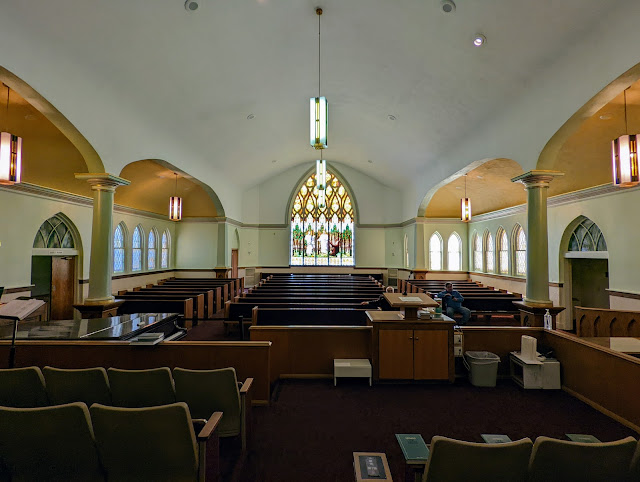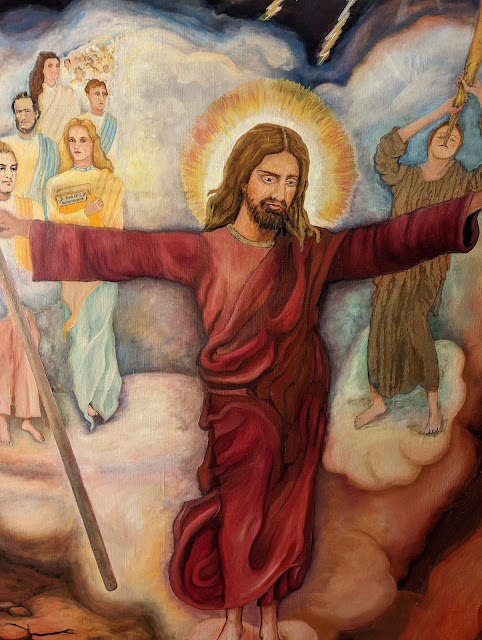This guest article was written by Ryan Hallstrom. He's from Upstate New York and is an editor at McGoff Media. He enjoys writing about religion, the history of ritual, and sacred architecture.
The Longfellow Park church was built in the 1950s on the former site of the Massachusetts Boston mission home. The land, just a few short blocks away from the campus of Harvard, was purchased by the Church from the Henry W. Longfellow estate. A mission home on the site was dedicated by President McKay in 1943. After about a decade, the mission home was cut in half and moved to another location before the chapel was built in the 1950s (see more here).
The original church caught on fire in May 2009 due to an electrical fire in the attic during a stake conference. Everyone was evacuated safely, but the structure was badly damaged.
 |
| (Image Source) |
In 2011, President Eyring dedicated the reconstructed 60-year-old meetinghouse. An article noted that "the old building was mostly destroyed, but much of the new building was designed as a replica of the original because of its historical significance. The tip of the steeple is 99 feet (30 m) above ground level.
The building was originally dedicated by President David O. McKay (1873–1970) in 1956, and a number of distinguished members have attended there, including President Eyring, President Packer, and former Massachusetts governor Mitt Romney.”
I like this meetinghouse. It really blends in with the local architecture.
I especially love the entrance. It’s very inviting as it’s close to the curb with a small garden, wide steps, and a pillared porch. This church is right on the street — meaning there’s no parking lot that you have to traverse.
I also like how many windows this meetinghouse has. There are a lot of window styles incorporated into the design. I saw several bay windows, some floor-to-ceiling windows, and there’s even a large circular window in the chapel. The result is a meetinghouse with a lot more natural light than you’d see in your average modern church building.
Going through the front door, there’s a small vestibule that opens into a large foyer. On the left, there’s a compartment with a wall of lockers.
Since this building houses three single adult wards, many of whom are students, I think the lockers are a nice amenity to include.
The massive foyer has a section with large, almost floor-to-ceiling windows.
In the chapel, the pulpit is on the left of the stand. Since the pulpit is on the left and the circular window is in the center of the chapel, the speaker doesn’t look washed out. I think this is a good way to bring more light into the worship space without distracting ward members.
I really like that the ward I attended kept the large side windows open instead of covering them with drapes during the meeting. I think it was a nice addition to the reverent atmosphere.
Unlike most chapels I’ve been in, here, the sacrament table is at the same level as the congregation (i.e., not on the stand).
At the back of the chapel is a small balcony with enough room for maybe 20 people to sit during meetings.
This church has many classrooms of different shapes and sizes. I particularly enjoyed seeing this small one that has a bay window in the back.
I found this small classroom on the second floor with a large glass wall.
A nearby hallway is lined with large windows looking down into the first-floor gym. The gym was sectioned off into maybe 3 or 4 different compartments.
Windows at the other end of the hallway look out onto 18th-century homes. Just across the street is the former home of Henry W. Longfellow (which also served as a headquarters for General Washington during the Revolutionary War).
Near the elevator, a large Relief Society room on the second floor mirrors a “priesthood room” directly beneath it on the first floor.
The Longfellow Park church is a good example of sensible historic preservation within the Church. I’m glad that, rather than replacing it with a modern, standard-layout meetinghouse, the Church chose to take carefully reconstruct and restore one of the first Latter-day Saint meetinghouses in New England.









































.jpg)

.jpg)
.jpg)
.jpg)